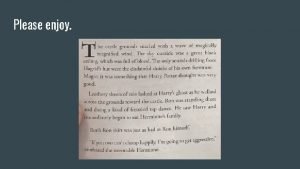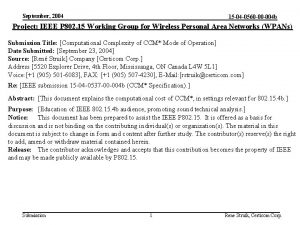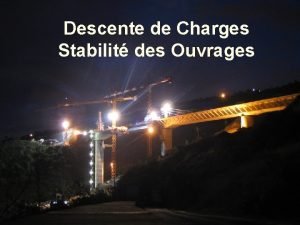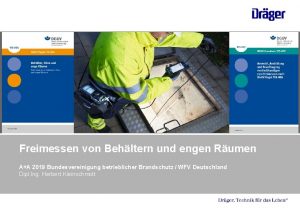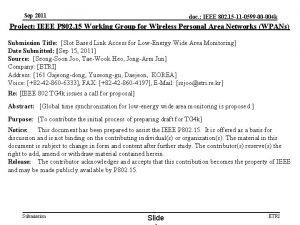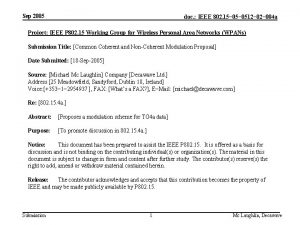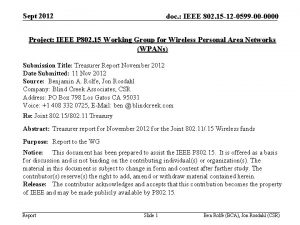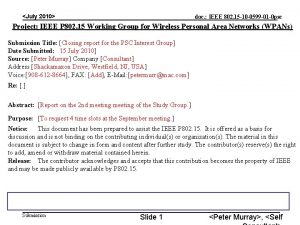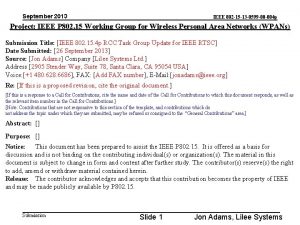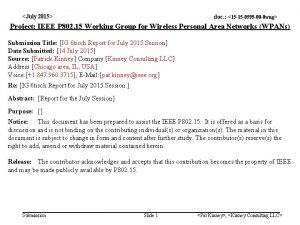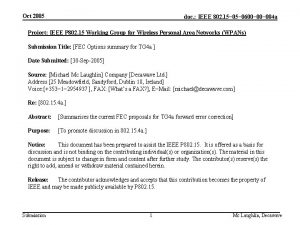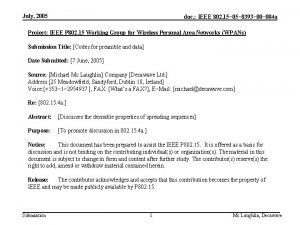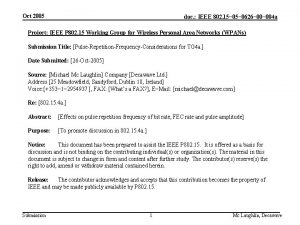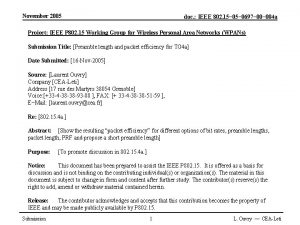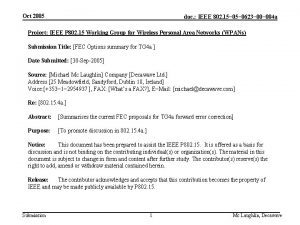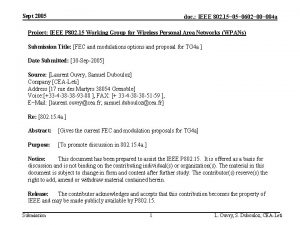Sep 2005 doc IEEE 802 15 0599 004














- Slides: 14

Sep 2005 doc. : IEEE 802. 15− 0599− 004 a Project: IEEE P 802. 15 Working Group for Wireless Personal Area Networks (WPANs) Submission Title: [Rate 1/4 code for TG 4 a] Date Submitted: [22 -Sep-2005] Source: [Michael Mc Laughlin] Company [Decawave Ltd. ] Address [25 Meadowfield, Sandyford, Dublin 18, Ireland] Voice: [+353− 1− 2954937 ], FAX: [What’s a FAX? ], E−Mail: [michael@decawave. com] Re: [802. 15. 4 a. ] Abstract: [Proposes a FEC scheme for TG 4 a data] Purpose: [To promote discussion in 802. 15. 4 a. ] Notice: This document has been prepared to assist the IEEE P 802. 15. It is offered as a basis for discussion and is not binding on the contributing individual(s) or organization(s). The material in this document is subject to change in form and content after further study. The contributor(s) reserve(s) the right to add, amend or withdraw material contained herein. Release: The contributor acknowledges and accepts that this contribution becomes the property of IEEE and may be made publicly available by P 802. 15. Submission 1 Mc Laughlin, Decawave

Sep 2005 doc. : IEEE 802. 15− 0599− 004 a FEC Options FEC 1 SOC K= 3, 4 or 5 R = 1/4 FEC 2 Convolutional Encoder K= 3, 4 or 5 R= 1/4 Coherent Receiver: Non Coherent Receiver: True Rate = ¼ Equivalent to Rate = ½ (Rate ¼ with erasures) Convolutional Encoder K=3, R= 1/2 Systematic Convolutional Encoder K= 3, 4 or 5 R = 1/2 Coherent Receiver: Non Coherent Receiver: Concatenated code, Rate = ¼ Convolutional code, Rate = ½ FEC 4 BCH or RS GF(28): RS(40, 32) GF(26): RS(43, 53) Systematic Convolutional Encoder K= 3, 4 or 5 R = 1/2 Coherent Receiver: Non Coherent Receiver: Concatenated code Rate = 0. 4 RS code, Rate = 0. 8 FEC 5 Systematic Convolutional Encoder K= 3, 4 or 5 R= 1/2 FEC 3 Submission Coherent Receiver: Convolutional code Rate = ½ Non Coherent Receiver: Uncoded 2 Mc Laughlin, Decawave

Sep 2005 doc. : IEEE 802. 15− 0599− 004 a Rate ¼ Coherent – Non Coherent mode: Use rate ¼ convolutional code punctured to rate ½ for non-coherent receivers - Coherent receiver sees all 4 generators • • Submission g 1=25, g 2=12, g 3=23, g 4=16 k=5 dfree=15 # parallel paths=1 3 Mc Laughlin, Decawave

Sep 2005 doc. : IEEE 802. 15− 0599− 004 a K=5, Coherent Receiver g 1=25, g 2=12, g 3=23, g 4=16 • # parallel paths=1 Submission 4 Mc Laughlin, Decawave

Sep 2005 doc. : IEEE 802. 15− 0599− 004 a Non Coherent Receiver g 2=12, g 4=16 => Rate ½ K=4 • dfree = 5 • about 3. 0 d. Bs performance improvement over uncoded at 10 -2 • 8 state decoder Submission 5 Mc Laughlin, Decawave

Sep 2005 doc. : IEEE 802. 15− 0599− 004 a Rate ¼ K=5 Performance 10 PER 10 10 10 AWGN PER for Rate 1/4 K=5 g=[25, 12, 23, 16] (Blue) and Rate 1/2 K=5 0 -1 -2 g = 33, 02 non-antipodal (Option 10 coherent) g = 33, 02 non-antipodal (Option 10 non-coherent) g = 35, 23 antipodal (Option I) -3 Coherent rate 1/4 Non-coherent rate 1/4 10 Submission -4 2 4 6 8 Eb/No 10 6 12 14 Mc Laughlin, Decawave

Sep 2005 doc. : IEEE 802. 15− 0599− 004 a Lower Complexity K=4, Rate ¼ Code g 1=17, g 2=04, g 3=15, g 4=06 • Coherent Receiver sees all generators – k=4, dfree=13, # parallel paths=2 – Exactly the same as best BPSK K=4 Rate ¼ code • Non-Coherent Receiver sees only g 2 and g 4 – g 2=04, g 4=06 – k=3, dfree=3, # parallel paths=1 – Compare to best dfree of 5 for k=3 Submission 7 Mc Laughlin, Decawave

Sep 2005 doc. : IEEE 802. 15− 0599− 004 a Sub Optimal K=4, Rate ¼ code g 1=17, g 2=04, g 3=15, g 4=07 • Coherent Receiver sees all generators – – dfree=12, k=4 # parallel paths=1 lose ~0. 35 d. B for dfree, gain ~0. 2 d. B for #parallel paths overall lose ~0. 15 d. B • Non-Coherent Receiver sees g 2 and g 4 – g 2=04, g 4=07 – k=3, dfree=4, # parallel paths=1 – Compare to best dfree of 5 for k=3 Submission 8 Mc Laughlin, Decawave

Sep 2005 doc. : IEEE 802. 15− 0599− 004 a Compare K=4, Rate ¼ and K=5, Rate ½ 10 PER 10 10 10 AWGN PER for K=4, Rate 1/4 and K=5 Rate 1/2 0 -1 -2 [17, 04, 15, 06] Coherent -3 [17, 04, 15, 06] Non-coherent [17, 04, 15, 07] Coherent [17, 04, 15, 07] Non-coherent 10 Submission g = 33, 02 non-antipodal (Option 10 coherent) g = 33, 02 non-antipodal (Option 10 non-coherent) g = 35, 23 antipodal (Option I) -4 2 4 6 8 Eb/No 10 9 12 14 Mc Laughlin, Decawave

Sep 2005 doc. : IEEE 802. 15− 0599− 004 a Rate ¼ K=4 and K=5 Performance 10 PER 10 10 10 AWGN PER for Rate 1/4 K=4, Rate 1/4 K=5 and Rate 1/2 K=5 0 -1 -2 K=4 Rate ¼ Optimal Coherent -3 K=4 Rate ¼ Opimal Non-Coh K=5 Rate ¼ Non Coherent K=5 Rate ¼ Coherent g = 33, 02 non-antipodal (Option 10 coherent) g = 33, 02 non-antipodal (Option 10 non-coherent) g = 35, 23 antipodal (Option I) 10 Submission -4 2 4 6 8 Eb/No 10 10 12 14 Mc Laughlin, Decawave

Sep 2005 doc. : IEEE 802. 15− 0599− 004 a K=4 Optimal vs Sub Optimal 10 AWGN PER for Rate 1/4 K=4 g=[17, 04, 15, 06] and g=[17, 04, 15, 07] 0 [17, 04, 15, 06] Coherent [17, 04, 15, 06] Non-coherent [17, 04, 15, 07] Coherent [17, 04, 15, 07] Non-coherent PER 10 10 Submission -1 -2 -3 -4 2 4 6 8 Eb/No 10 11 12 14 Mc Laughlin, Decawave

Sep 2005 doc. : IEEE 802. 15− 0599− 004 a Rate ¼ need 4 bits / uncoded bit ~1000 ns 2 codes transmitted every microsecond Submission 12 Mc Laughlin, Decawave

Sep 2005 doc. : IEEE 802. 15− 0599− 004 a Original Option 1 Proposal ~1000 ns 2 codes transmitted every microsecond Submission 13 Mc Laughlin, Decawave

Sep 2005 doc. : IEEE 802. 15− 0599− 004 a Summary • Performance of K=4 rate ¼ sub-optimal code recommended (17, 04, 15, 07) • Coherent performance as good or better than Rate ½ K=5 • Non-Coherent performance also good. 1% PER at ~10. 5 d. B Eb/No Submission 14 Mc Laughlin, Decawave











